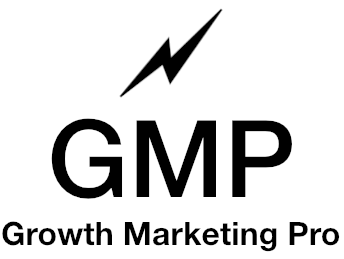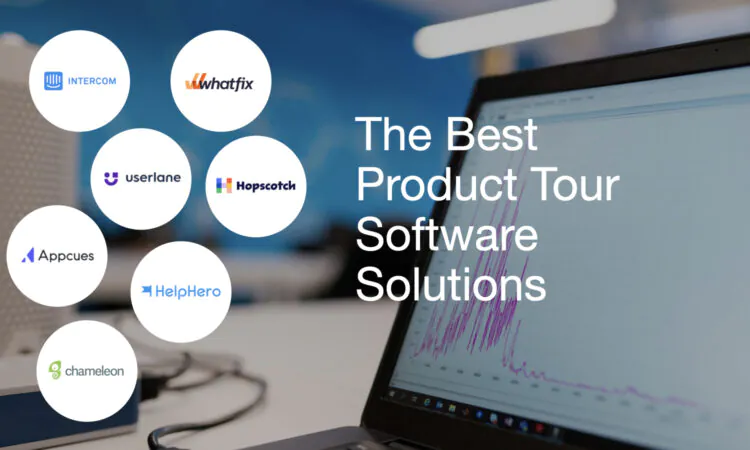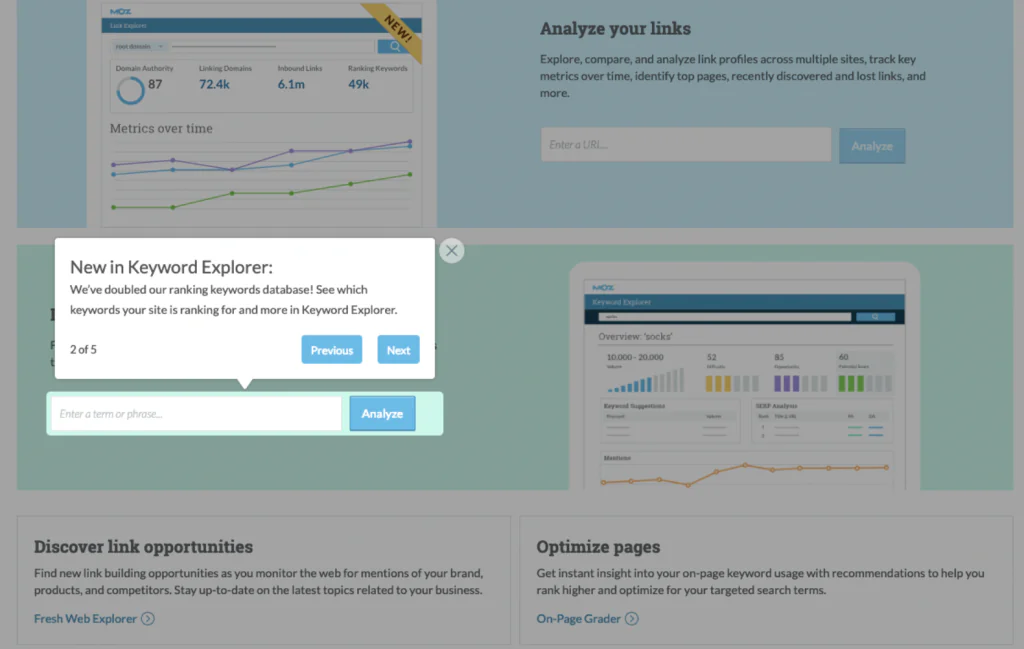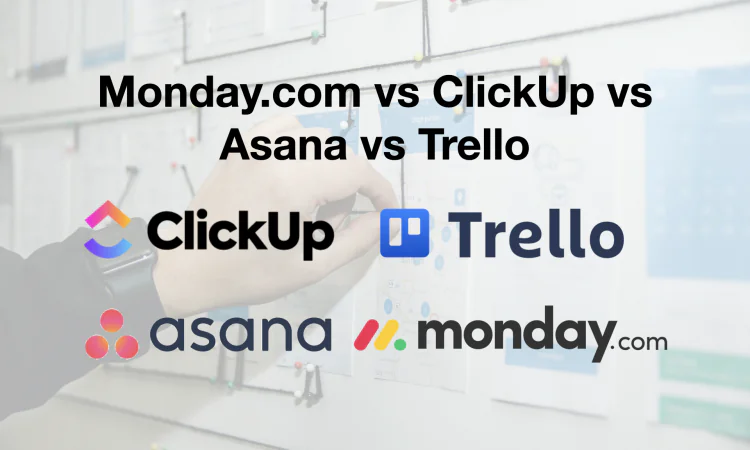- The 14 Best AI Sales Software Tools - July 30, 2025
- 13 Best Product Tours Software - July 18, 2025
- What is Generative Engine Optimization (GEO) and the 9 Ways to Do It - March 26, 2025
According to ProfitWell by Paddle, SaaS growth (as measured by CAGR) peaked in 2022. So if you’re building a SaaS business today, you need every possible tool to grow users and reduce churn.
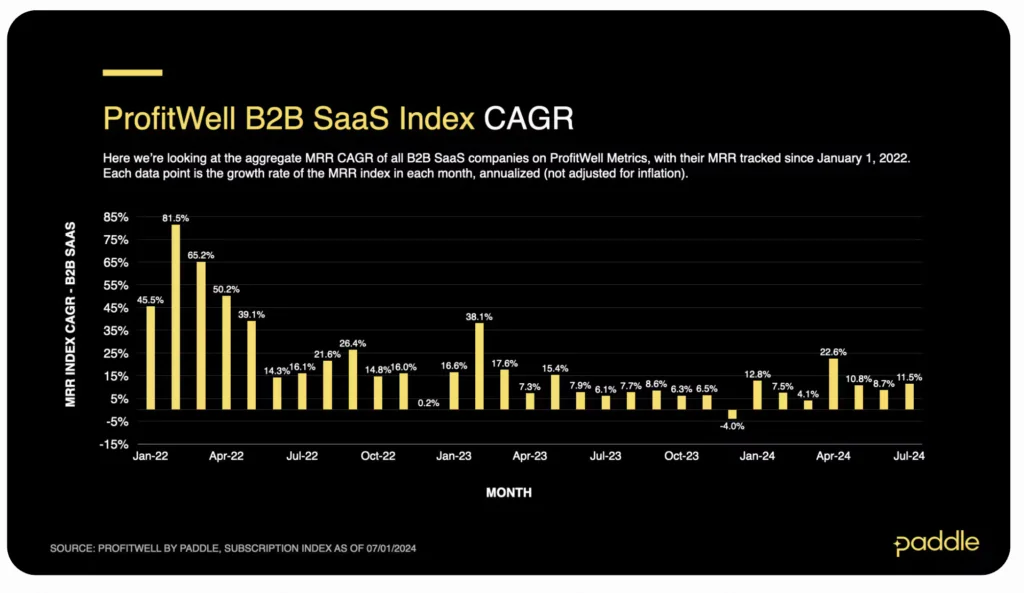
One of the most powerful categories of tools for onboarding and retaining users is product tour software.
Product tour software enables SaaS businesses to create no-code tours that:
- Show off product features
- Onboard and educate users
- Reduce friction, enabling users to reach critical “aha” moments faster
When we were building our SEO tool, GrowthBar, we did a fair bit of research into the best product tour software and product onboarding platforms. We wanted to make sure our customers would not only know how to use GrowthBar, but also be excited to start using it by the end of the tour.
Lo and behold, after implementing a product tour experience, we increased our conversion to paid users by 11%. And it increased our customer lifetime value by 5%, due to better retention. That’s a lot of revenue for not much effort!
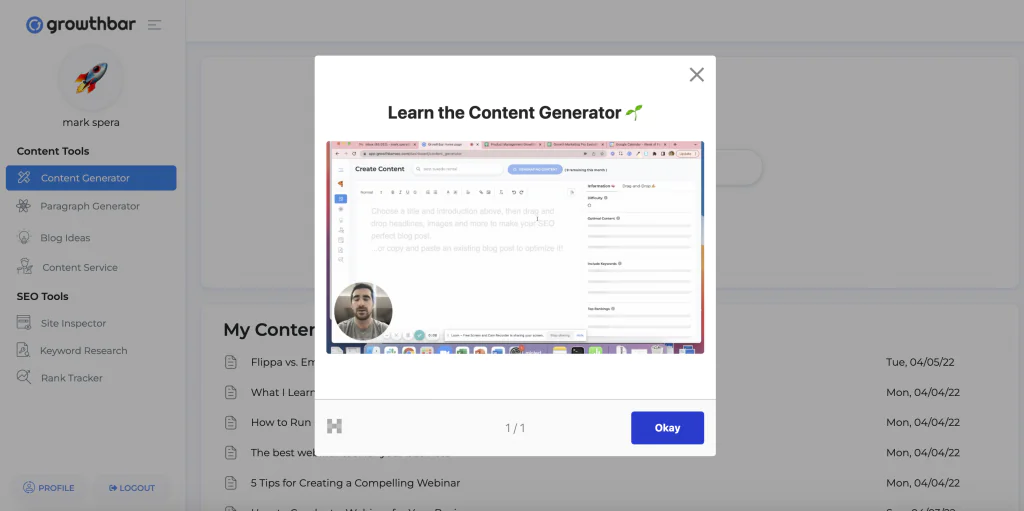
And from this research, trying product tour software, and making our own product tour, grew the list of the best product tours software on the market today.
Table of Contents
What is product tour software?
Product tour software–sometimes called product walkthrough software–helps companies create interactive product and platform demonstrations. Often used by SaaS businesses (software as a service), product tour software can be used to show off a product’s features and help users learn how to use step by step.
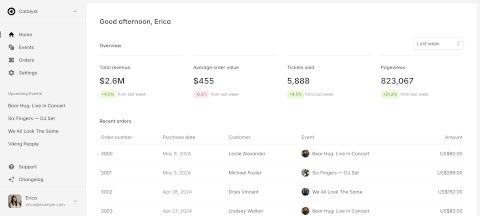
Of course, product tour software isn’t just for software or online platforms–you might take an online product tour for anything from a flight booking website to an ecommerce business selling an air fryer.
But no matter the product, a poor product touring experience can lead to frustrated users that are no longer interested in using your product, so you want to invest in the best product software for your business.

Best Product Tour Software Tools
What are the best product tour software solutions? Keep reading to find out!
📚 Also read: UserGuiding vs Userpilot vs Appcues vs Pendo
🚀 Looking for a SaaS marketing agency? Learn about us here
1. Hopscotch

Hopscotch is a best-in-class product tour software that enables you to make customized product onboarding flows, which will help drive adoption and reduce churn. We ended up choosing Hopscotch as our product onboarding solution for GrowthBar because of its simplicity (one line of code to drop on the app) and ease of use. The price is pretty awesome too.
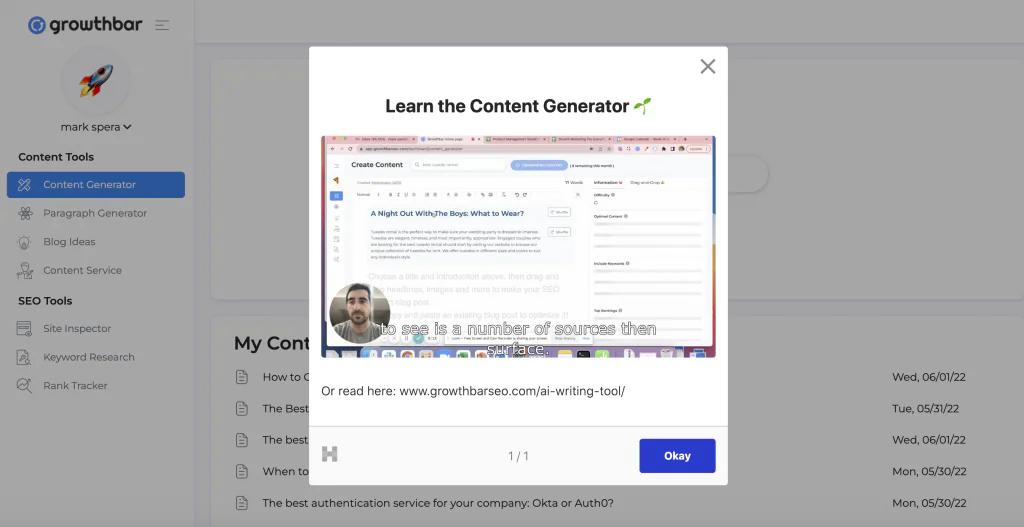
Hopscotch is the perfect solution for entrepreneurs and small-to-midsize SaaS businesses. Unfortunately, it does not have checklists and on-hover help widgets like a few other (more expensive) tools on this list. So if your use case is simple, Hopscotch may be perfect.
Features:
- Onboard users with product tours that can include image, video, GIF and text
- Super easy, hassle-free pixel that makes getting up in running painless
- Guide users through new features
- Choose how many times and when to show tips to users
- Notify users about upcoming product features, webinars, and more
- Use conditional logic to segment in-app messaging based on individual user activity
- Easy preview experience, so you know what things look like before you publish
- Great email support
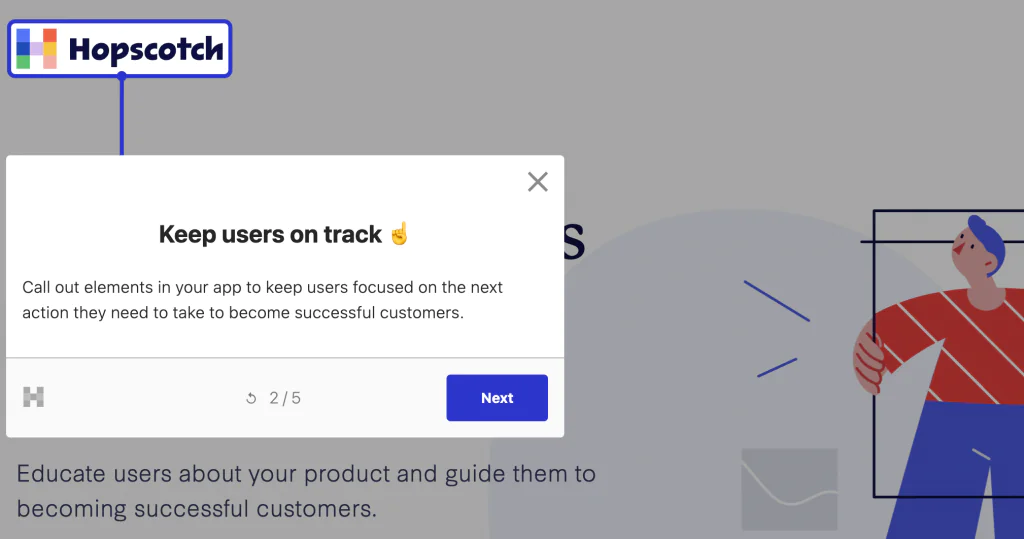
Pros?
- One of the most affordable options
- Easy to use with great results (we’ve used it!)
Cons?
- Limited analytics options
- Not as many options as more robust platforms, which include Q&A and NPS information
Pricing:
- Starter: $99/mo for up to 3,000 users
- Growth: $249/mo for up to 20,000 users
- Enterprise: pricing not provided
2. Consensus
Consensus is the first comprehensive product experience platform designed to help revenue teams create educational, inspiring, and truly engaging product demonstrations. This unique product tour software tool lets you create interactive product tours with engaging video demos, dynamic product content, and all the assets you need to make buying simple.
Buyers can completely personalize their own product demo journey: They tell Consensus what features they want to see the most, and then the platform customizes their demo experience for a perfectly personalized tour. They can also share your product tours with key stakeholders.
As your champions and stakeholders go through their product tours, you receive crucial intent data. You’ll see who is viewing your tours, how long they’re viewing them, how often they’re returning to them, and much more. This intent data tells your sellers when and how to move your buyers to the next steps.
Features:
- Interactive Product Tours: Guided experiences that let buyers view and try products in controlled, contextualized environments
- On-Demand Video Demos: Personalized video demos that address specific use cases and pain points based on buyer preferences
- Automated Product Simulations: One-click sandbox demo experiences that provide data-rich POC experiences without engineering support
- DemoBoards: Secure, branded landing pages where buying groups can explore and share product experiences
- Stakeholder Discovery: Tools that help identify and engage all decision-makers in complex buying committees
- CRM Integration: Seamless connections with major CRM platforms for streamlined workflow
- Actionable Intent Data: Analytics that reveal buyer preferences, feature rankings, and organizational heat maps
- AI-Assisted Demo Creation: Intelligent tools that help build compelling product demonstrations quickly
Pros?
- Reduces sales cycles through automated demos and stakeholder discovery
- Enables 24/7 selling with self-service product experiences
- Supports the entire buyer journey from initial interest to purchase decision
- Works for both sales and marketing teams to generate and nurture leads
Cons?
- Primarily for pre-purchase product tours
- Premium pricing may not fit smaller team budgets
- Requires initial setup and content creation
Pricing:
Consensus’ custom pricing plans are based on role and license quantity.
3. Appcues

Appcues takes away the stress of creating custom onboarding flows for your products with little or no code. And with Appcues’ Google Chrome Extension builder, you can make pixel-perfect, drag-and-drop experiences to analyze via their dashboard for prime optimization.
While Appcues can be prohibitively expensive for some companies, it’s a very strong product–maybe even the best in terms of its feature set and software sophistication. Plus, with $32M+ of venture capital, you know more great features are coming down the pipeline for Appcues.
Features:
- One line of code installation and segment integration
- Create and target user segments based on virtually any behavior (like the completion of another flow or using a specific feature) or attribute (like job title or location)
- Easy preview experience, so you know what things look like before you publish
- Integrations with Zapier, Heap, Google Analytics, Salesforce, HubSpot, Slack and more
- No-code builder with drag-and-drop images, custom designs, and easy editing
- Analytics to track impact of onboarding flows on user behavior
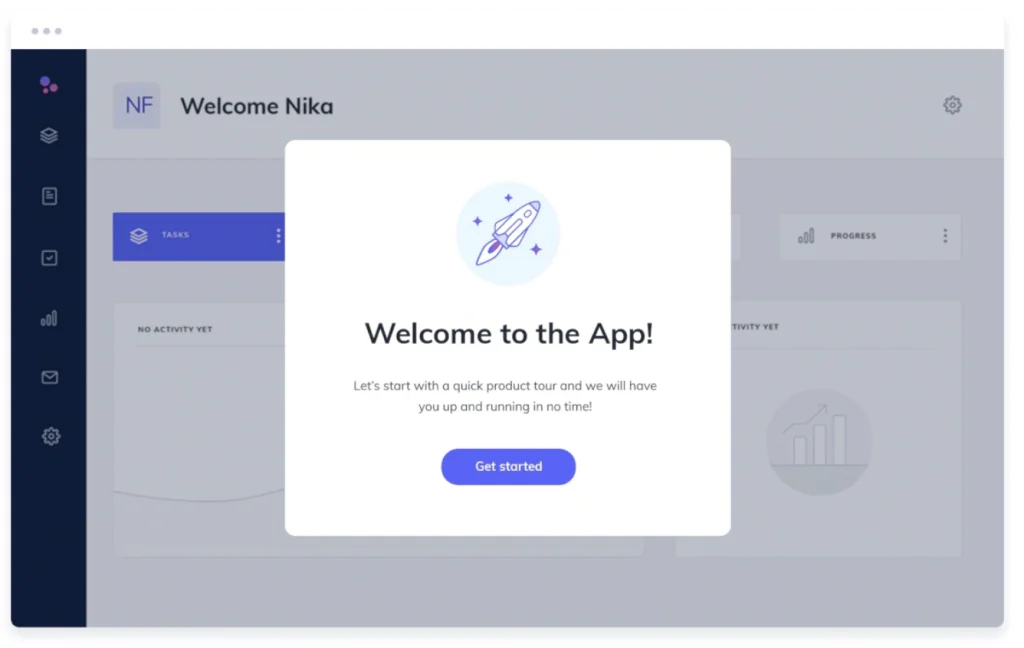
Pros?
- Advanced feature set
- Easy design options without any coding
Cons?
- Enterprise-level pricing
- For full design control, you’ll need to use CSS
Pricing:
- Essentials: $249/mo for 3 user licenses, 10 trackable events, and up to 2,500 monthly active users
- Growth: $879/mo for 10 user licenses, 20 trackable events, advanced targeting capabilities, and full customer support and up to 2,500 monthly users
- Enterprise: Book a demo for more information
4. Chameleon
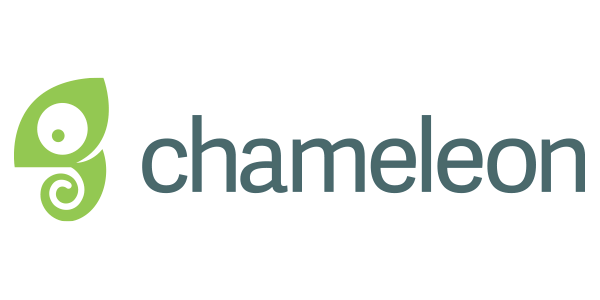
Chameleon’s goal is to be your go-to tool for product engagement by using surveys, tooltips, checklists–and of course product tours. With banners, modals, hotspots and more, you can use Chameleon product tours to design powerful flows for user guidance and product launches.
With WYSIWYG editing (what you see is what you get) you can build your tour and watch it in real time, and then edit with their advanced styling options and custom CSS. Not into CSS? It’s a no-code platform, so it’s only a bonus.
At one of the higher price points on this list, you’ll want to make sure you need all of their features before purchasing.
Features:
- Tooltips can be dynamically employed to keep users moving through your product
- Microsurveys build continuous feedback throughout the user cycle
- Customizable in-product widgets can become checklists, help menus, or more to help with feature discovery
- Accessible editor so you can build and edit your tours on the go
- Preview testing and the ability to instantly become live without needing to wait for product cycles or dependencies
- Audience segmentation using data using attributes, actions, tour engagement, and events from integrated apps
- Sequential product tour options
- Conversion and engagement analytics
Pros?
- Bespoke coding option for specific needs
- Wide variety of UX options
Cons?
- More expensive option on this list
- UI can have a higher learning curve
Pricing:
Chameleon pricing varies on how many unique profiles that use Chameleon per month (MAU). So with 2,000 profiles, pricing starts at:
- Startup: $279/month
- Growth: $849/month
- Enterprise: Contact them for a quote
Once you hit 20,000 MAU, Startup is at $825/month, and you need to contact them directly for both Growth and Enterprise pricing.
5. HelpHero

HelpHero allows you to create interactive, easy-to-follow product tours that will help your users get started and adopt new features. Plus, with automated user guidance and no-code capabilities you can reduce customer service inquiries and give your engineering team a break.
With customizable product tours–at a more affordable price point–HelpHero is a good option for product tours software.
Features:
- Feedback and gratification boosts for users that complete onboarding steps
- Tooltips, feature announcements, and prompts to nudge users
- In-depth analytics that tracks completion rates
- Target specific users through tour branching and conditions based on language, device, browser and custom user properties
- Create, edit, and preview product tours in real time without any coding required
- Easy customization of in-app look and layout
- Compatible with HTML based apps, whether mainly client-side (React, Vue, etc) or server-side (PHP, ASP.NET, etc
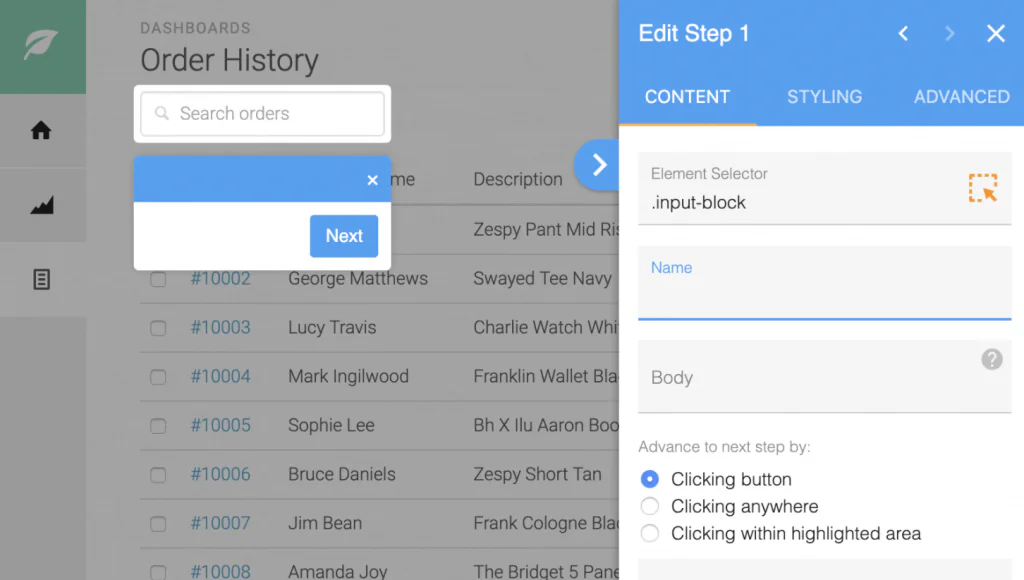
Pros?
- Accessible price points
- A/B testing option
Cons?
- Limited to linear and branching onboarding
- No-code styling options can be limited without using CSS
Pricing:
This is HelpHero monthly pricing, though HelpHero yearly customers get two months free.
- 1,000 MAU: $55/month
- 2,500 MAU: $115/month
- 5,000 MAU: $179/month
- 10,000 MAU: $249/month
- 20,000 MAU: $299/month
- For more than 20,000 MAU, you’ll need to contact them directly.
6. Intercom

Intercom is another full-service customer engagement platform that offers chat-based customer support software, shared inboxes, campaign builders, and product tours. Their main goal throughout all their products is to improve conversion rates, reduce churn, and keep your customers happy.
Their product tours feature is no different, offering the ability to create interactive guides, provide guidance at pain-points, and highlight new features–all without coding. Unfortunately, you can’t buy the product onboarding suite on its own, so Intercom is a fantastic solution if you need multiple features, but it’s not just a product onboarding tool.
Features:
- Web chat, in-app chat, email, video, and phone support with features like one-click chat, customer feedback, and satisfaction survey
- Audience segmentation and targeting
- Customizable templates, unique design features, and various message styles
- Create customized, conversational bots to qualify leads, triage support inquiries and more
- Use targeted email, mobile push, and in-app messages to encourage customers to take action, or convert visitors to loyal customers. Outbound Messages enable you to onboard, and proactively support your customers on the web and in your mobile app
- Simple integration with one line of code on your app or site
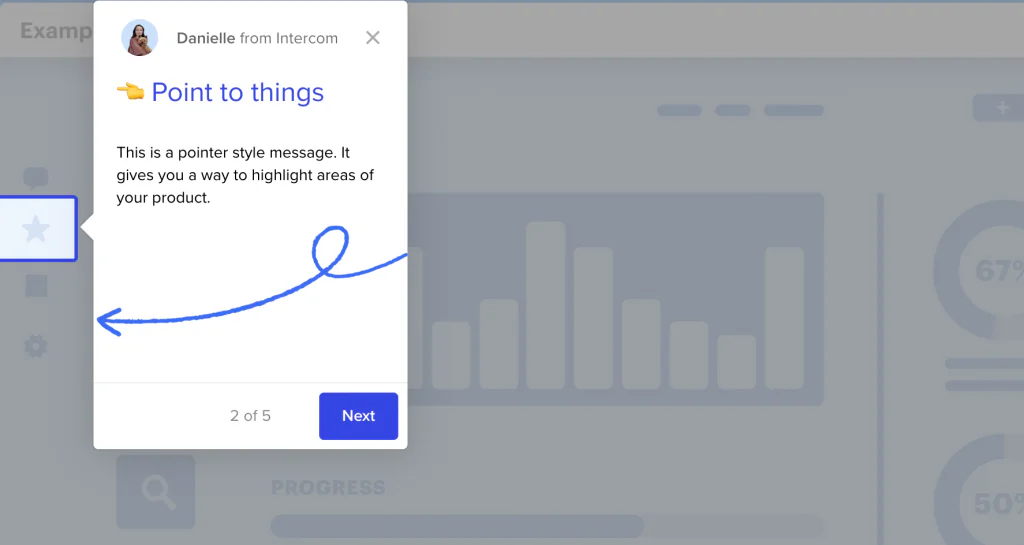
Pros?
- Integrates with all Intercom products
Cons?
- Only supports linear onboarding
- Limited styling options without any coding
- If you only want a product tours software, you might not want to pay for the rest of what Intercom provides
Pricing:
- Starter: $67/mo
- All other plans are custom and require a demo
7. Nickelled

Nickelled offers guided tours, hotspots, and help assistants to reduce churn, improve feature adoption, and make it easier for users and employees alike to understand your product.
Nickelled guided tours show your users what they need to see on the page, dynamically and in real-time. Augmented with their eye-catching hotspots and on-page widgets, Nickelled makes product touring easier at a more affordable price.
Features:
- Hotspots to showcase new or important features or work users through friction points
- On-page widget that provides comprehensive support and learning resources that suggest tours and helpful documentation
- No-code software with easy customization
- Offered in multiple languages
- Tracks completions, drop-offs, progression, and satisfaction rates
- Multiple roll-out options including shareable URLs, Javascript, and browser extension
- Advanced segmentation tools and matching data
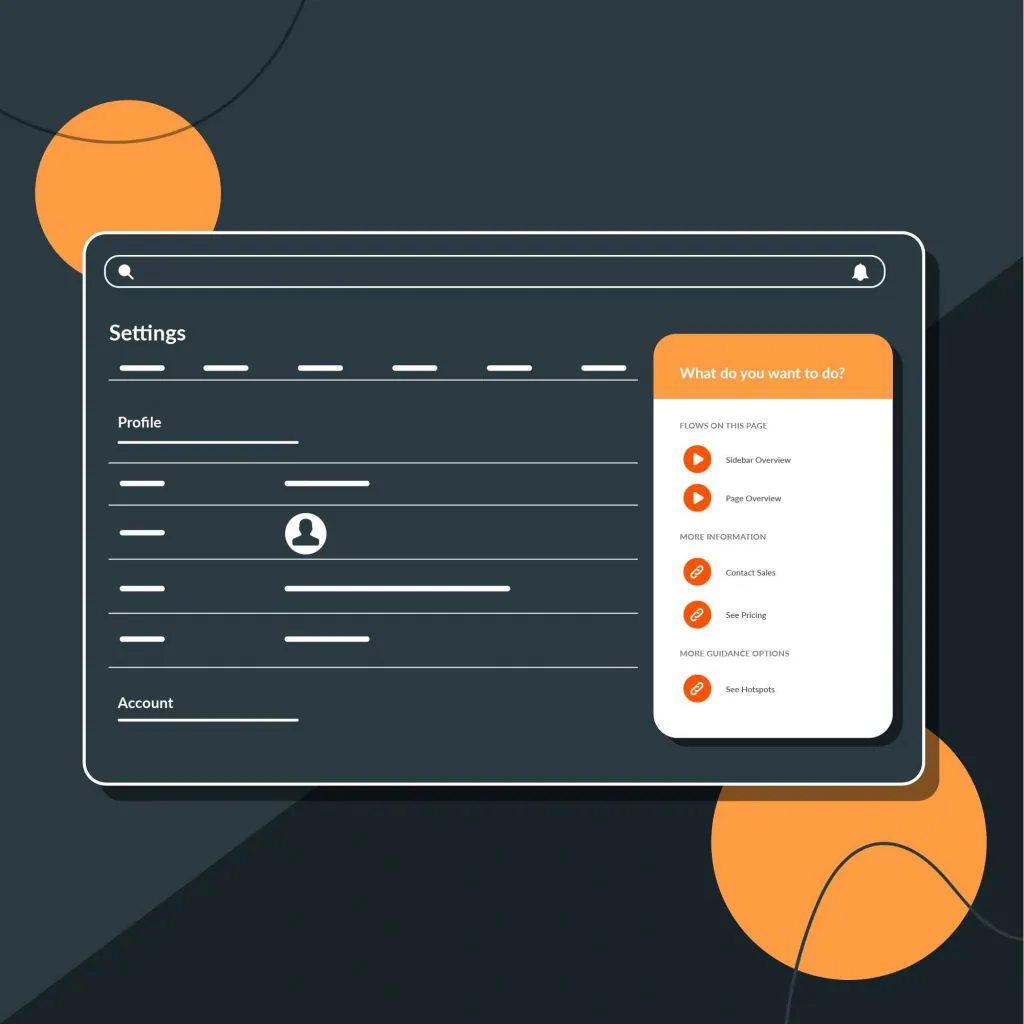
Pros?
- More affordable price-point
- 14 day trial for every package
- Focused on product tours
Cons?
- Few branching or interactivity options
Pricing:
- Starter: $99/month
- Growth: $199/month
- Premium: $399/month
8. Pendo

Pendo is an enterprise software company that delivers an experience that is personalized, predictive, and delightful. It’s all about building relationships and focuses on product experience, digital adoption, and services & support. Pendo is used by world-class brands like Microsoft, Adobe, and Cisco to deliver personalized experiences for their customers.
Pendo hangs its hat on product analytics, but of course it also has an incredible in-app guide feature, which enables you to set up flows and onboard users seamlessly.
Features:
- Best-in-class product analytics suite to understand which features are most important for users
- No-code tracking of all product activities, so you never have to add additional lines of code to capture user data
- Product onboarding suite is one of the most sophisticated, and includes in app guides, product callouts, and announcements
- Tooltips and best practices delivered in-app, with tailored messages for specific customer segments
- In-app guides include web guides, mobile guides, guide templates, guide scheduling and ordering, resource center, localization, accessibility features, and guide experiments
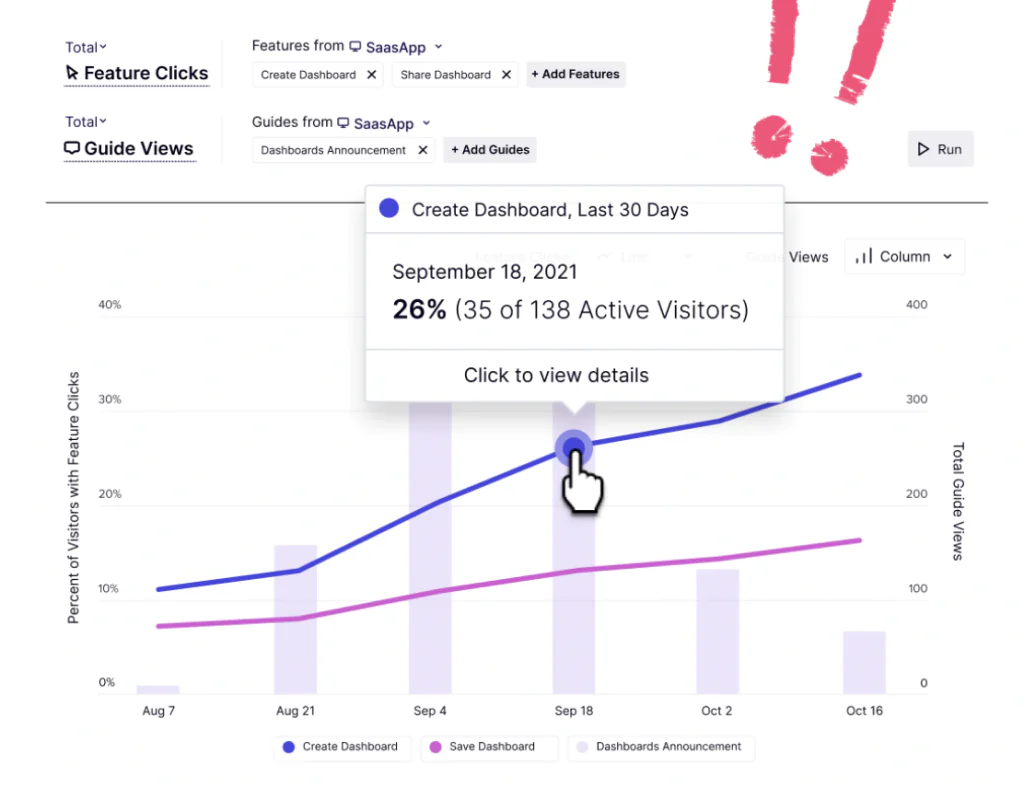
Pros?
- Pricing plans for different aspects of the product: you don’t have to purchase all in one
- But, also offers various options if you need more support with client experiences
Cons?
- Quickly gets expensive
- Slightly confusing pricing structure
Pricing:
Pendo has pricing for three customer plans: Adopt, Feedback, and Engage, which we’ll list here since it includes the in-app guide options
- Free: Limited in-app guides for up to 1,000 monthly visitors
- All other plans require you to speak with a salesperson – Pendo gets expensive fast
9. Product Fruits

Product Fruits is a comprehensive suite of product onboarding tools. It’s a relatively new tool, but it has everything you’ll need to onboard users effectively. It enables you to add all sorts of onboarding widgets to lead users through their first-time experience.
It also has all the triggered events you need to customize flows to the language and persona of your users, and get feedback within your app experiences and export all the data you collect.
Features:
- Step-by-step no-code product guidance
- Localize your product tours to different languages
- Target users based on different personas
- Create beautiful onboarding experiences with no-code and preview your experiences
- Get feedback from users and announce new features
- Allow users to record images and record videos
- Export all data to CSV for easy analysis
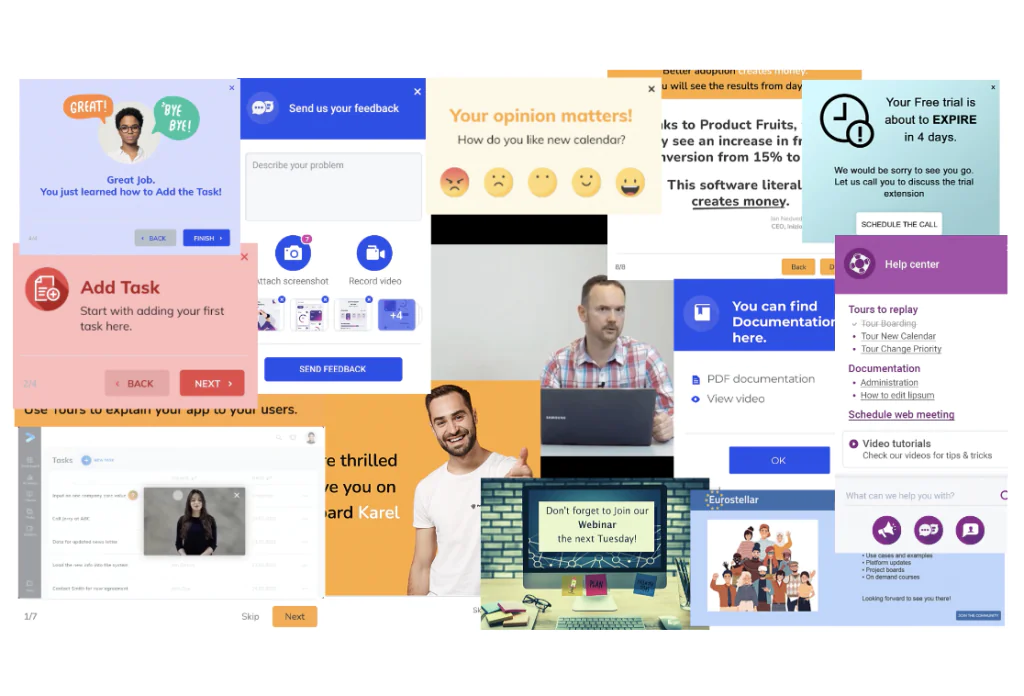
Pros?
- More affordable price point
- Easy to set up and use
Cons?
- UI could use an update
Pricing:
- Growing: $59/mo for up to 1,500 monthly users ($459/mo for up to 50,000 monthly users)
- Enterprise: Inquire for more information
10. UserGuiding

UserGuiding offers self-serve user onboarding so you don’t have to provide manual support. Onboard your users with product walkthroughs that don’t require any coding so you can prompt the right in-app experience, to the right persona, at the right stage of their user journey.
With clients seeing a decrease in support calls, and an increase in feature adoption and user activation rate, UserGuiding offers a variety of options to keep your customers happy.
Features:
- Centralized resource center for blogs, webinars, and help articles
- In-depth analytics and NPS to view user statistics and make decisions
- Personalized onboarding experience for each user with segmentation options
- Onboarding checklists that guide your customers step by step and turn them into power users
- Customization using simple emojis, images, GIFs and videos to enhance modules and tooltips
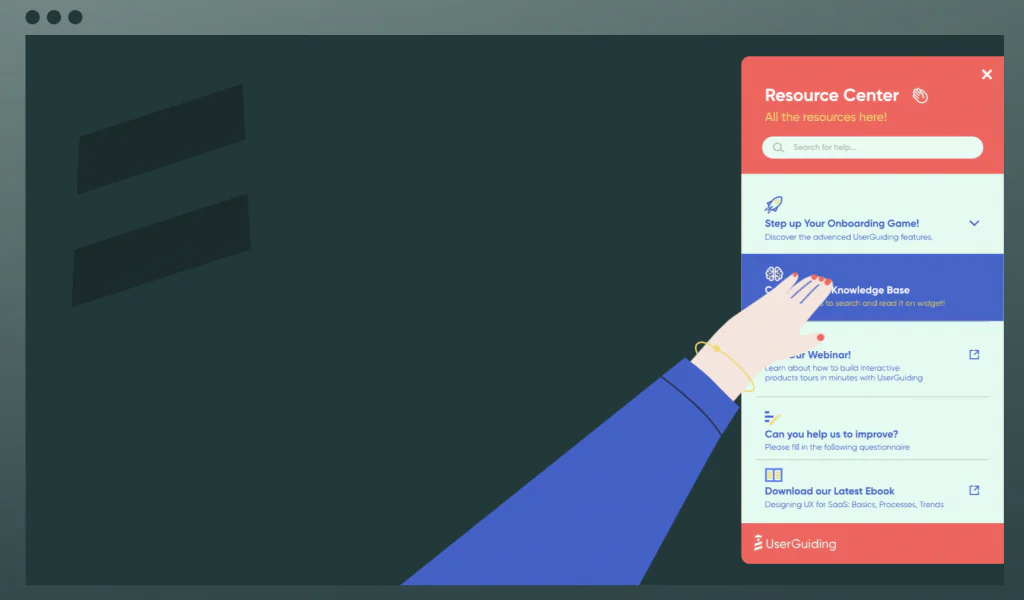
Pros?
- No coding required
- Yearly discount for plans and free trials for their Basic and Professional plan
Cons?
- Might need technical skills for implementation
- Higher learning curve
Pricing:
- Basic: $99/month
- Professional: $399/month
- Corporate: $699/month
11. UserPilot

UserPilot helps product teams deliver personalized in-app experiences to increase growth metrics at every stage of the user journey. Userpilot enables you to engage users with a no-code product onboarding suite, track and analyze growth, plus get feedback and NPS scores from users with simple popups.
If what you’re looking for is a product onboarding tool, it has everything you need and nothing you don’t. With no-code tour building and straightforward analytics, it’s tough to beat. But, it comes at an enterprise price similar to Appcues, so make sure the price point is worth it.
Features:
- Capture usage trends and growth insights with one code drop, which records all events as soon as it’s on your site
- Establish goals and track progress to those goals, much like you would in Google Analytics
- Create personalized engagement flows with no code
- Create contextual experiences based on conditions like “user has taken X action”
- Run A/B tests on your onboarding experiences to find winning combinations.
- Gather feedback with no-code surveys and NPS prompts directly in your app
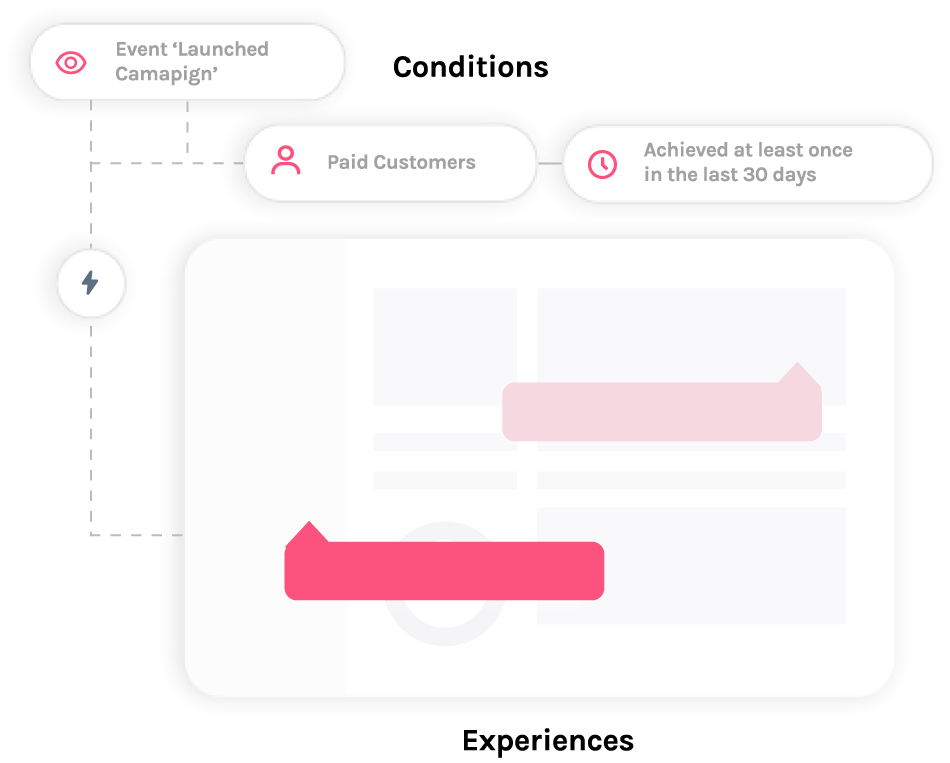
Pros?
- Branched & interactive product tours
- No-code editor and interface (WYSIWYG)
Cons?
- Doesn’t have a mobile app feature
- Enterprise-level pricing
Pricing:
- Traction: $249/mo for all features up to 2,500 users
- Growth: $499/mo for all features up to 10,000 users
- Enterprise: $1,000/mo paid annually for all features, up to 2,500 users plus GDPR compliance, user permissions, and phone support
12. WalkMe

WalkMe’s digital adoption platform helps maximize user adoption through no-code technology and digital experiences. For marketplaces, market research, DAP professionals, institutes, and communities, WalkMe is a full-service engagement platform that also provides product onboarding tours that analyze, measure, and optimize customer journeys.
Features:
- Management dashboards to improve tech stack visibility and demonstrate digital experience analytics of user experience
- Recreate user journeys by viewing past user sessions in video or list, to analyze user journeys and points of unintended friction
- Code-free editor to make strategically placed and personalized on-screen content, cross application guidance, user segmentation engagement, on screen automation, content validation, and more
- Various integrations including Salesforce, AWS, Slack, Google Analytics, and more
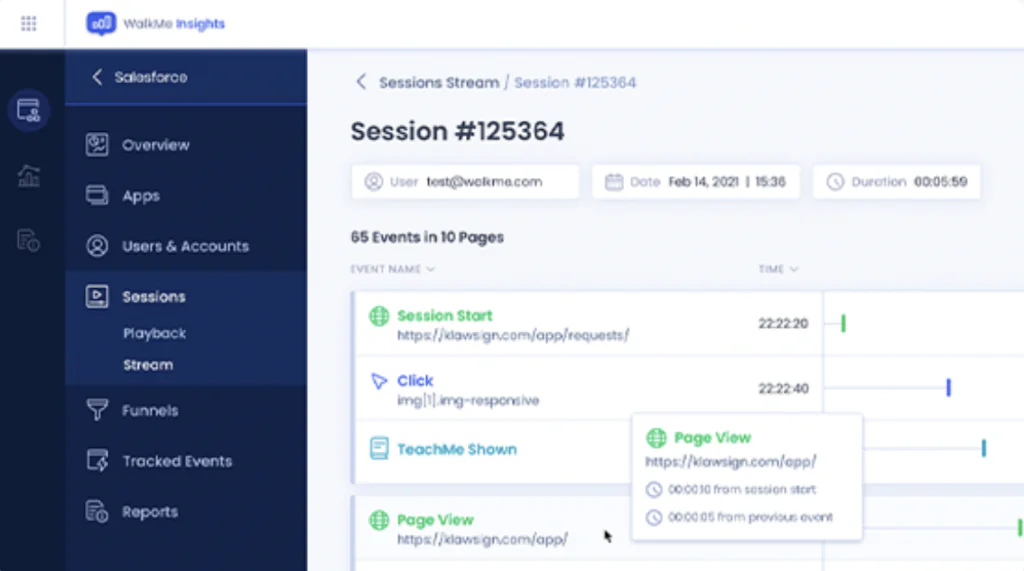
Pros?
- 60-day free trial
- Various product engagement options
Cons?
- One of the most expensive on this list–really for enterprise-level businesses
- Include features and options you might not need if you’re really only looking for product tour software
Pricing:
- You’ll need to get a quote for all of their pricing plans.
13. Whatfix

Whatfix expands digital capabilities through contextual experiences designed to increase proficiency and productivity across all applications for everyone, and every team. Get guidance analytics, user analytics, and collect feedback.
There are beautifully designed no-code templates, so you can deploy your experience without the assistance of a developer.
Features:
- To integrate and deploy Whatfix on your web application, all that you need is a single line of code.
- Guides can be easily created and edited by anyone in multiple browsers like Google Chrome and Mozilla Firefox.
- Customizable displays and templates.
- Smart targeting allows you to perform user-level segmentation on different web pages.
- Actionable data on user behavior within applications, consumption of Help content, and real-time feedback on in-app experiences
- In-app guidance and contextual self support, announcements, and feedback opportunities
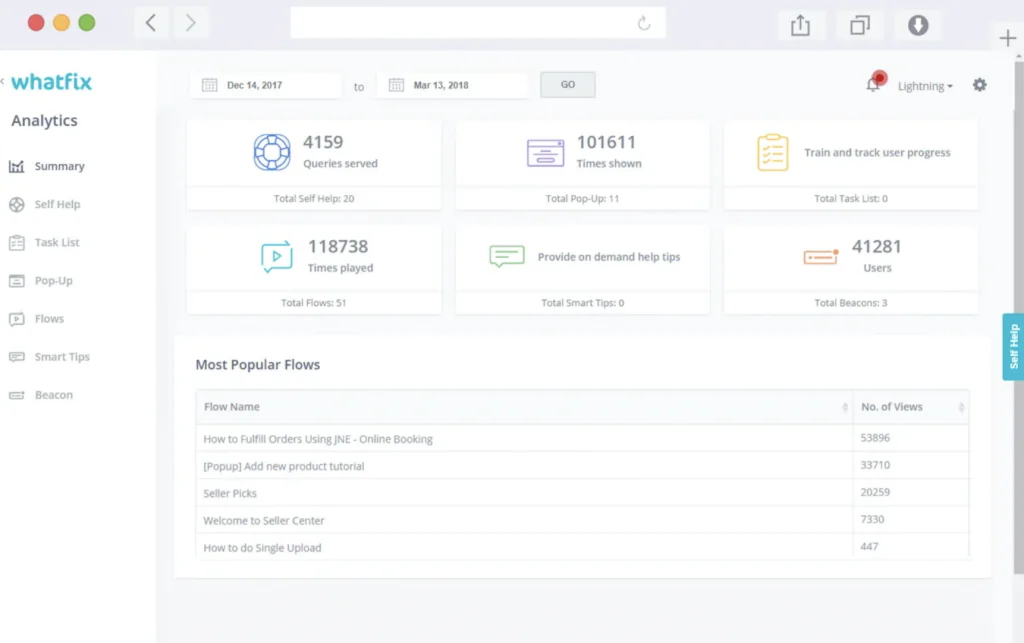
Pros:
- No-code integration
- Easy install
Cons:
- No listed pricing
- Not many in-app styling options
Pricing: Contact for pricing.
How is product tour software used?
Product tours software is a great way to showcase your products to potential customers. You can build a tour that highlights your product’s features and viewers can seamlessly learn more on a click-to-advance journey. The best product walkthrough platforms allow you to quickly and efficiently make beautiful product tours that are neat, engaging, conversational, and interactive.
Plus, since they’re often no-code platforms, product tour software makes it easy on your business: instead of hiring coders or using up your product engineers’ valuable time, you can create a tour of your product or update without needing coding knowledge.
A product tour can also be a great marketing tool if you’re involved in product-led marketing growth.
What is product tour software used for?
You can use product tour software for:
- Onboarding new hires
- Explaining your product to new customers
- Demos for investors
- Showing off a new feature
- And really anything you want!
Overall, product tour software is used to improve productivity, reduce friction points, and automate a lot of the time-intensive tasks listed above. In turn, this should keep user satisfaction and retention higher, and improved ROI…without needing an engineering and coding team to build your own tour in-house!
Product tour software vs. product onboarding software
Product tour software and product onboarding software are similar, but product onboarding is going to encompass product tours…as well as perhaps email marketing, support documents, live chat, videos, and any other resource that can help quickly onboard a new user.
Product onboarding softwares, or customer onboarding software, helps customers learn your product faster and therefore begin using–and hopefully loving it–faster. And in a great product user onboarding process, you should definitely include a product tour.
How to make that product tour? The best product tour softwares of course!
Tips for setting up a product tour or walkthrough
Once you’ve chosen the best product tour software for your organization, team, and customers, the next step is setting up the product tour.
Luckily, with product tour platforms, a lot of the work is done for you, so you just have to make a couple decisions to decide how you best want to reach your users and what are the most important elements to cover (no one wants a product tour that’s hours long).
Understand the customer journey
One of the most important parts of the product tour is determining when you want to offer it. Is it for potential customers to show them how great your product is? Will it be after sign-up with a video via email when they first make an account? The first time they sign on? Both?
Deciding when is going to be just as important as what, and knowing the customer journey and any pain points it might include is a huge part of this. Plus, ensuring your product tour can fit into your overall product onboarding will make the entire process easier for your users.
Personalize the experience
You’ll want your product tour software to offer as much audience segmentation and targeting as you can get. While having a general product tour is a great first step, being able to recognize potential issues for different types of consumers–enterprise vs. small business, Ecommerce vs. webinar software–and customizing your product tour to address those will improve the product tour experience.
A product tour shouldn’t be one-size-fits-all. Customization and personalization can be the difference between a free trial and a paid subscription. Knowing who your customers are, and the key differences between them, will support your product-led growth goals.
Provide next steps
A product tour is a great resource to offer new or potential customers, but it shouldn’t stop there. Providing your “tourist” a next step will encourage greater adoption levels, whether customers are new or have been using the product for a while.
Depending on where you offer the product tour on the customer journey, “next steps” can look like completing a purchase, taking an action to start making the product tour, looking at some product tour examples for inspiration, trying out a specific product feature, and more.
Include additional resources
Another option for a next step could be providing additional support resources for your users. Or, include these during hot-spots or via live chat throughout the tour.
While product tours can be great for most of your users, all of us learn differently, so having comprehensive written guides, video lessons, and other elements beyond the tour is crucial to reduce customer support queries and increased user satisfaction.
All of these resources should have cross-platform compatibility, so users can access them across all browsers and devices.
Use the analytics
The best product tour software should have advanced analytics that allow you to provide a comprehensive look on how the product tour is doing for adoption, churn, retention, and satisfaction.
These analytics should make it clear how each part of the product tour is doing, and what improvements can be made, so take advantage of them!
Conclusion: Best product tour software for customer onboarding?
Product tours are an incredibly important step in user onboarding, especially with the increasing number of self-serve platforms for online softwares and new technologies. Creating a customized, comprehensive product tour within your onboarding series–or before–can be the difference between a user actually becoming a serious user or…not.
What is the very best product tour software? All of the options on this list are going to be a great start, and I suggest narrowing down by price-point and need first. We personally used Hopscotch for the product tour of GrowthBar, and it was great (and affordable), but any of the options on this list will give you a great product tour.
📚 Also read: UserGuiding vs Userpilot vs Appcues vs Pendo
🚀 Looking for a SaaS marketing agency? Learn about us here
